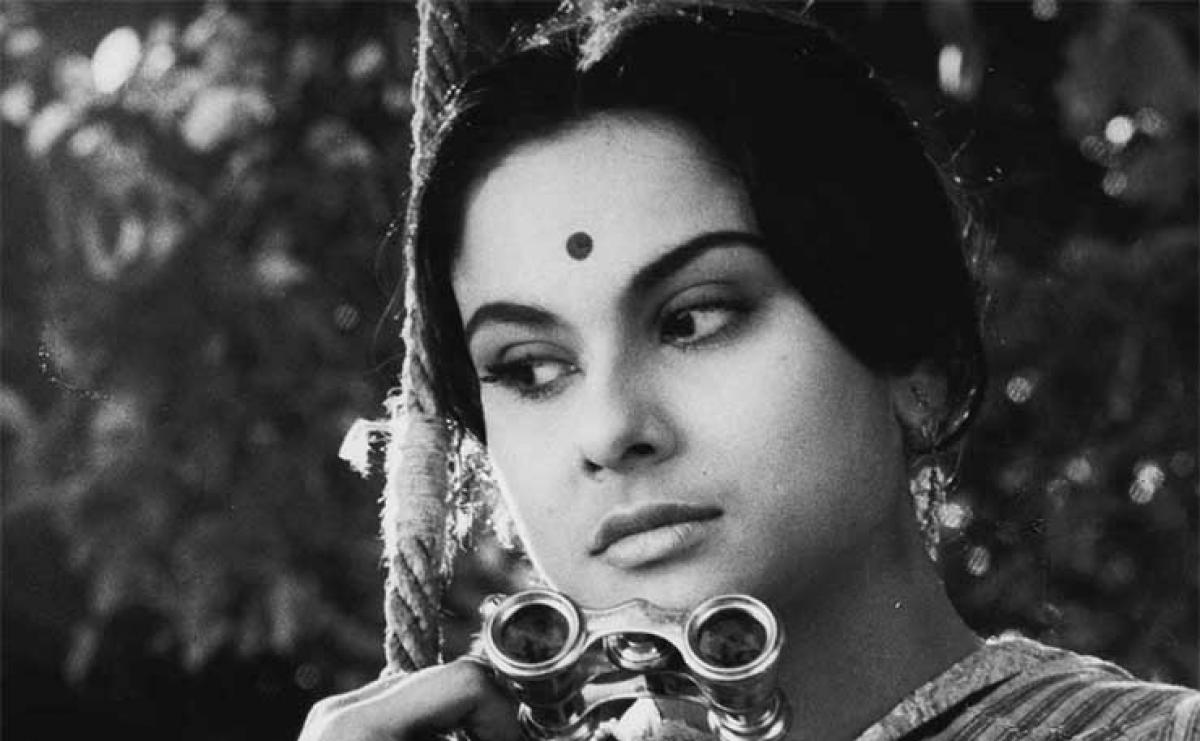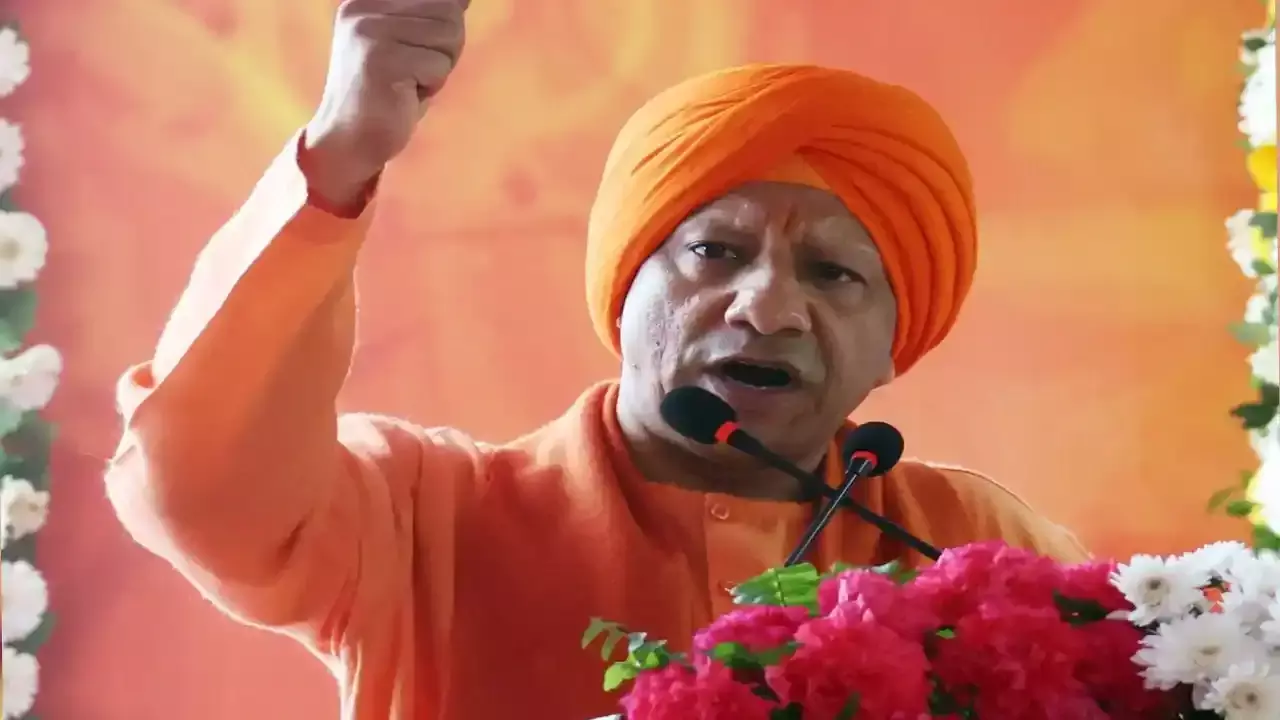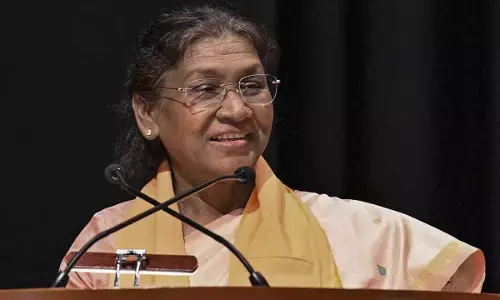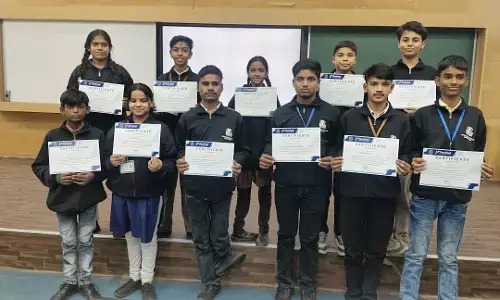Gurudev lives on In hearts

Gurudev lives on In hearts. The multidimensional personality that Gurudev Ravindranath Tagore was… his admirers continue to worship him, live his teachings and sing his music, even today.
The multidimensional personality that Gurudev Ravindranath Tagore was… his admirers continue to worship him, live his teachings and sing his music, even today. To hold on to a phenomenon called Tagore in few words is a daunting task. However, our attempt to gather spirited Hyderabadi folks influenced by Tagore’s works was fruitful. Right from Chandana Khan (Special Chief Secretary to Government, Tourism, Archaeology & Museums) to Dr Anil Mandal (Ophthalmologist), Janajit Ray (Principal, DRS School), Whistle Wizard Eelapata Sivaprasad, poet and actor Tanikella Bharani, eminent dancer Shobha Naidu among others shared their Tagore stories with great gusto on the occasion of his birth anniversary on May 7.
When the heart is hard and parched up,
come upon me with a shower of mercy.
When grace is lost from life,
come with a burst of song.
When tumultuous work raises its din on all sides shutting me out from
beyond, come to me, my lord of silence, with thy peace and rest.
When my beggarly heart sits crouched, shut up in a corner,
break open the door, my king, and come with the ceremony of a king.
When desire blinds the mind with delusion and dust, O thou holy one,
thou wakeful, come with thy light and thy thunder
 In the ‘parched’ scenario of despondency, this poem brings in a welcome shower of hope. It wouldn’t be an exaggeration if we say Gurudev Rabindranath Tagore, like the Sun, emanated many rays, which kindled creativity, spirit of unity, and sparked off great thinkers of his clan. While some worship him as a Guru, some adore him as a poet, artist, educationist, philanthropist and seer. Perceived in different ways Tagore seems like a kaleidoscope of life-colourful, vibrant, intense, mystifying and magnetic.
In the ‘parched’ scenario of despondency, this poem brings in a welcome shower of hope. It wouldn’t be an exaggeration if we say Gurudev Rabindranath Tagore, like the Sun, emanated many rays, which kindled creativity, spirit of unity, and sparked off great thinkers of his clan. While some worship him as a Guru, some adore him as a poet, artist, educationist, philanthropist and seer. Perceived in different ways Tagore seems like a kaleidoscope of life-colourful, vibrant, intense, mystifying and magnetic.
One look at Dr Anil Mandal’s (an ophthalmologist in LV Prasad Eye hospital) room- and you’d know what’s meant by ‘seething with passion’! This doctor who seems to be ‘breathing’ Tagore has certainly created history by dedicating all his time and life to live Tagore’s teachings. He says - whenever desolation loomed large on him, memoirs of ‘Geetanjali’ caressed and cajoled and gave him a fresh lease of life. This was how he started writing poems and translating his Gurudev’s works. Coming from an ordinary family from Bengal, Anil’s father inspired by Tagore’s works encouraged Anil to become a doctor to save the rural lives. Right from the age of three, Tagore lived with him through anecdotes, poems, stories and intellectual discussions that echoed in the four walls of his home at all times. His book ‘Naivedya’–is a translation of more than 75 poems of Tagore in both Bengali and English versions. Another book ‘Sangeetaanjali’- marks the 100th year of Tagore’s Nobel Prize. These songs composed by Mandal within a year-from 2012-13, reflect all facets of life with insightful thoughts. Says Mandal “My Bengali songs in this book are for my Bengalee countrymen and English transcreations are for my audience beyond the borders of Bengal”
Prof. Balasubramanian Director of Research at LVPEI says Anil’s passions for Rabindra Sangeet and poetry reflects in his patients too. Even an infant responds to him with great love, perhaps that’s the magic of poetry!”
A poet and writer in English and Telugu, NS Murthy shares, “My appreciation of Tagore until I attended an interview for the post of a Maths lecturer at a College in Repalle, near Tenali, was merely as a writer of our National Anthem. It was more mob-like national pride. I read his poem "Where the world is Without Fear.." on the wall of the college for the first time. This poem had changed my opinion about Tagore and I could immediately understand his angst behind every word and how even the greatest of civilisations reduce to nothing if the followers do not understand the spirit behind the finer concepts and practices and reduce them to rituals by perfunctory operations. Today, Tagore to me is a great humanist.”
It was when Tanikella Bharani had first visited Madanapalli to address school children there that he discovered that Gurudev had penned our national anthem at Madanapalli. He shares, “Vishwakavi’s works deeply impacted me, especially his lines ‘where the mind is without fear and the head is held high…” always echo in my heart. I even used these lines for my dramas in early stages of my career as playwright. In my Telugu play ‘kokkoroko’, it is a wakeup call against social evils. I think there isn’t any writer, poet or thinker who isn’t influenced by Tagore.”
Another Telugu writer who translated Tagore’s ‘Fruit Gathering’ into Telugu ‘Nivedana’, is Turlapati Rajeshwari Devi –presently living in Berhampur after having served as Telugu Professor in Orissa. Speaking on Tagore’s musical poetry, “He had an uncanny ability to weave most beautiful thoughts into poems. She says the poetic scaffolding he gave to seemingly dreary subjects like philosophy and spirituality earned him admirers throughout the country, cutting across the borders language and region. Pointing out at ‘Fruit Gathering’, which is an array of interesting stories, she says - Tagore’s yearning as a fruit gatherer to become one with the Supreme Intelligence of the yonder can even melt a sceptic! It is this Indian soul in him that touched every Indian and established oneness, arousing a spiritual thirst in all those who read his works.
When asked about why she chose this particular book for translation, “When I first read the book in English, Telugu words started pouring into my mind involuntarily; it was then that I decided to go ahead with translation. It was a great moment for me when Vishwabharati granted permission to do it and gave me the following compliment that I will cherish forever!”
“Rajeshwari has done the translation credibly; she succeeded in bringing out the rich imagery and imagination of Gurudev’s original work. The mystic’s ecstasy as well as the agony of the poet is brought out in appropriate Telugu idiom”
The highest and healthiest education, according to Gurudev Tagore, is that which does not merely give us information, but puts our life in harmony with all existence. “Can you imagine a Vishwabharati or Global University in those days? Gurudev made it happen and I deem it a privilege for having been nurtured in the lap of Shantiniketan ,” says JanajitRay , Principal DRS School Hyderabad. Tagore’s school wasn’t clinical, it had a free spirit and thirst for knowing, which obviously is limitless. Since he knew it so well, he never confined students within the four walls of the classroom. Students who seemed to be loitering in the campus, under the trees were actually in a constant transaction with nature, which in turn nurtured their creativity.
As an educationist Ray tries to implement what he absorbed in Shantiniketan. “Wherever I went as a Principal, I made music, dance and art mandatory at least up to grade 8. In fact I’ve introduced a novel ‘tutorial’ in our school which is a small group of students that slowly expands with the method of inclusion. This way, our students don’t compete or fight by dividing, but unite by including the rest.”
Ray’s family moved to Shantiniketan when he was around seven, since then he literally grew up in Tagore’s lap through his poetry and music. He is a fan of Rabindra Sangeet and his sister Promita Mallik is a Rabindra Sangeet singer well known across Bengal and she too had the privilege of studying at Shantiniketan. “The intense emotions portrayed in Gurudev’s works bring the beseeching pain of a lover for the beloved: the pinnacle of experience lies in experiencing his poetry through his music, which is Rabindra Sangeet”, says Ray.
It’s not surprising to see a streak of this eccentricity in all Tagore lovers who vouch by his poems that come to their rescue when the going gets tough. Says Chandana Khan “I often recall Gurudev’s poems when I am feeling low. It’s not a bit of exaggeration when I say that his poems are always etched on the canvas of my heart and mind, when time comes I just have to close my eyes and the poem runs through my veins, it soothes me. Whenever I feel the need to recharge the artist in me I take a break and go to Shantiniketan where I have a small place for myself. Just being there is like being with Gurudev. Another most intriguing thing is that the seasons there are so pronounced and enjoyable that you would never want to miss the onset of any season, especially monsoon!”
Famous Kuchipudi dancer Shobha Naidu shares that she can never forget her Guru Vempati’s training for Tagore’s classic ballet ‘Chandalika’. She says, “In those days we would go to interior rural belts to give performances and every time we staged ‘Chandalika’ there was an overwhelming response when people used to stand and sing the national anthem. Such was his power!”
It was when his Guru Balamuralikrishna sang Rabindra Sangeet at Raja Rani Festival in Bhubaneswar, did Eelapata Sivaprasad (the whistle wizard) realise the magic of Rabindra Sangeet. He says the standing ovation that Balamurali got for the three songs towards the end of the program stunned him. He immediately said to himself that he would pay tribute to the great Tagore with his prowess –i.e., whistle. It took more than two years for him to understand the language which he did with the help of a Bengali dancer to be able to put it into the whistle format. “One has to understand the nuances of Rabindra Sangeet, its emotions and ups and downs to traverse with it and that can happen only after understanding and assimilating it.” In the year 2013, he released his album ‘AnandaDhaara’ – with tagline ‘Bliss Flows through Breath’—which is more than apt for the mellifluous whistle tune!
Anindita Mokhopadhyay, Associate Professor, University of Hyderabad has translated 'Shesher Kobita' (one of Rabindranath Tagore’s last novels that was serialised in 1928). Publishers ‘Rupa’ had brought it out under its original Bengali title, with an English translation -' The Last Poem'. Even as she finds Tagore’s works interesting, she does not totally agree with his portrayal of women. “Rabindranath has been translated by so many eminent scholars - Supriya Choudhury, Ketaki Kushari Dyson and William Radice come immediately to mind - that I feel a little diffident about my future plans for translating Tagore's works. ‘Chaturanga’, as a novel, really fascinates me and so does 'Chaar Adhyay'. When I say that they are fascinating, I mean that they relay to me a huge range of emotions of the times that we will never experience. It is common knowledge that Rabindranath had explored women's minds and their 'pain'- sensitively. Certainly! But he also had very clear convictions about women's work, their world, their natures - and I find these angles equally important to pin the time and the place of a society constantly evolving. As a historian and social scientist it is important for me to understand the society through the traces left by words in works of fiction. They convey to me a series of very powerful impressions of lived lives.”
Her critical views emerge out of the lasting influence of the great litterateur, “Tagore was a modern liberal, with a strong sense of cultural moorings. For him, women were the essence of these deep moorings. Their world was compared to the necessity of the invisibility of night and sleep, which brought with it healing and rest and peace and harmony in the deep private spaces of the home. The metaphor of the 'day' with its activities, its hustle-bustle, its visibility did not belong to women. I find these metaphorical allusions very characteristic of the nineteenth and twentieth century patriarchal certainties about what constituted a wholesome and creative society. This is a critical take on 'Gurudev'. But he is still the 'guru' without the halo for me. Criticism and a critical attitude is far more indicative of exerting a lasting influence than an unquestioning and uncritical acceptance of a 'myth' about the ‘Gurudev’," she explains.
“I think a critical engagement with this great literary figure would be more useful for retrieving him to enrich our own times, rather than to create a hagiography that would not speak to us and our concerns.
Tagore’s works travelled seamlessly transcending all the boundaries and barriers, sometimes they became a binding factor, while at times they spew out forcefully challenging deep rooted customs and practices of those days. Was he ahead of his times? Certainly yes!
















